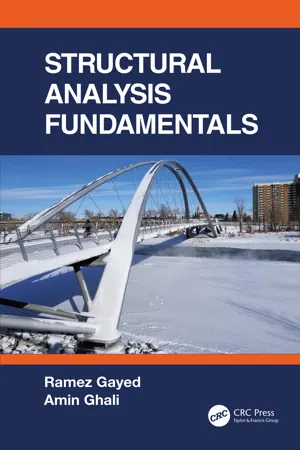
- 552 pages
- English
- ePUB (mobile friendly)
- Available on iOS & Android
Structural Analysis Fundamentals
About This Book
Structural Analysis Fundamentals presents fundamental procedures of structural analysis, necessary for teaching undergraduate and graduate courses and structural design practice. It applies linear analysis of structures of all types, including beams, plane and space trusses, plane and space frames, plane and eccentric grids, plates and shells, and assemblage of finite-elements. It also treats plastic and time-dependent responses of structures to static loading, as well as dynamic analysis of structures and their response to earthquakes. Geometric nonlinearity in analysis of cable nets and membranes are examined.
This is an ideal text for basic and advanced material for use in undergraduate and higher courses. A companion set of computer programs assist in a thorough understanding and application of analysis procedures. The authors provide a special program for each structural system or each procedure. Unlike commercial software, the user can apply any program of the set without a manual or training period. Students, lecturers and engineers internationally employ the procedures presented in in this text and its companion website.
Ramez B. Gayed is a Civil Engineering Consultant and Adjunct Professor at the University of Calgary. He is expert on analysis and design of concrete and steel structures.
Amin Ghali is Emeritus Professor at the University of Calgary. He is consultant on major international structures. He is inventor of several reinforcing systems for concrete. He has authored over 300 papers and eight patents. His books include Concrete Structures (2012), Circular Storage Tanks and Silos (CRC Press, 2014), and Structural Analysis (CRC Press, 2017).
Frequently asked questions
Information
Chapter 1
Structural analysis modeling
1.1 Introduction
1.2 Types of structures


Table of contents
- Cover
- Half-Title
- Title
- Copyright
- Contents
- Introduction to Structural Analysis Fundamentals
- Preface to Structural Analysis Fundamentals
- Notations
- The SI System of Units of Measurements
- Authors
- 1 Structural analysis modeling
- 2 Statically determinate structures
- 3 Introduction to the analysis of statically indeterminate structures
- 4 Force method of analysis
- 5 Displacement method of analysis
- 6 Time-dependant displacements in structural concrete
- 7 Strain energy and virtual work
- 8 Virtual work applications
- 9 Application of displacement method: Moment distribution
- 10 Effects of axial forces on flexural stiffness
- 11 Analysis of shear wall structures
- 12 Methods of finite differences and finite-elements
- 13 Finite-element analysis
- 14 Plastic analysis of plane frames
- 15 Yield-line analysis of reinforced concrete slabs
- 16 Structural dynamics
- 17 Response of structures to earthquakes
- 18 Nonlinear analysis
- 19 Computer analysis of framed structures
- 20 Computer programs
- Appendix A: Displacements of prismatic members
- Appendix B: Fixed-end forces of prismatic members
- Appendix C: End-forces caused by end displacements of prismatic members
- Appendix D: Reactions and bending moments at supports of continuous beams due to unit displacement of supports
- Appendix E: Properties of geometrical figures
- Appendix F: Torsional constant J
- Appendix G: Values of the integral ∫I Mu M dl
- Appendix H: Forces due to prestressing of concrete members
- Answers to problems
- Advertisement
- Index